Mì Quảng (Quảng-style noodle soup) is a must-try dish when you visit Hội An ancient town and Đà Nẵng city. I made Mì Quảng for my parents while I’m in Vietnam this time, and my dad even asked me to make it again.
So, here’s the authentic recipe for Mì Quảng. I tried to gather all the local ingredients to make the best version for my dad and mom, but I’ll also provide tips on substitutions to make the recipe easier to cook.

Table of Contents
What is Mì Quảng?
Mì Quảng is an iconic noodle dish of Đà Nẵng city and Quảng Nam province (home to the ancient town of Hội An). Historically, Đà Nẵng and Quảng Nam were part of the same larger province in the past.
When in Hội An, besides Mì Quảng, don’t forget to try Cao Lầu (noodles with five-spice braised pork) and Hoi An Chicken Rice.

Local people say that Phú Chiêm Village (Điện Bàn, Quảng Nam) is where Mì Quảng originated. Therefore, when visiting Hội An and Đà Nẵng, make sure to try Mì Quảng from Mì Quảng Phú Chiêm vendors.
Some interesting facts about Mì Quảng
- In Vietnamese, “Mì” often refers to wheat-based noodles like in Mì Khô (dry egg noodles with sauce) and Mì Xào Giòn (crispy bird’s nest egg noodles). Mì Quảng is the only exception.
- Sometimes you might hear about Phở Hà Nội, Phở Sài Gòn, or Bún Chả Hà Nội. It’s still okay to just call them Phở or Bún Chả. However, for Mì Quảng and Bún Bò Huế, the regions in their names are integral parts of their identities.
- In Vietnam, rice noodles are often served in two popular ways:
- As a rice noodle soup like Bún Mọc or Phở.
- As a rice noodle salad with Nước Chấm dipping sauce like Bún Bò Xào, Bún Gà Nướng or Bún Thịt Nướng.
Mì Quảng falls somewhere in between; the rice noodles are served with just a small amount of broth but packed with intense flavor.
Ingredients
In Vietnam, if you want to cook authentic Mì Quảng, you will need the local pearl onions from Quảng Nam (củ nén) and the extra-virgin peanut oil (dầu phộng).

- Củ Nén lends a unique aroma that sets them apart from shallots or garlic. If you can’t find them, white pearl onions make a good substitute. In a pinch, regular onions can work.
- If you have peanut oil on hand, I highly recommend using it for cooking Mì Quảng. Alternatively, regular cooking oil will be enough.
You can find the ingredients at Asian markets. For precise measurements, refer to the recipe card at the end of this post.
Noodles
The noodles for Mì Quảng are made from rice. They’re wide, flat, and slightly thicker and chewier than the rice noodles in Northern Phở.

In Vietnam, the color of Mì Quảng noodles could be white or yellow. So if you can’t find yellow noodles, flat rice noodles for Phở or Pad Thai are great substitutes.
As a last resort, you could use Ho Fun (Chow Fun) . These noodles, often used to cook Cantonese Beef Chow Fun and Thai Pad See Ew, are available in most Asian markets. They are thinner and more delicate than Mì Quảng Noodles.
Toppings
Traditional toppings for Mì Quảng are chicken with shrimps and quail eggs, or pork with shrimps and quail eggs.
However, today in Vietnam, you’ll find variations with both local staples and exotic ingredients such as beef, frog, snakehead fish, and even jellyfish.

My Mì Quảng today is with chicken and shrimps. I skipped the quail eggs this time because I forgot to buy 😂.
In Vietnam, we often break down a whole chicken to cook Mì Quảng because the bones impart more umami flavors. You can use chicken drumsticks or boneless chicken thighs.
Moreover, adding chicken broth enhances the broth’s flavor even further.
I don’t recommend chicken breast since it tends to dry out when braised.
For the shrimps, in Vietnam, we use shell-on shrimps (ones that are not too big and have thin yet crunchy shells), but you could use peeled shrimps.
Aromatics & Coloring

- Aromatics: củ nén (pearl onions or onions), shallots, and garlic.
- Coloring: fresh turmeric (or turmeric powder) and annatto oil (or paprika powder and some cooking oil).
- Be cautious with your cooking utensils as turmeric and annatto oil can stain.
Seasonings
The broth of Mì Quảng is richer and saltier than the broth of other Vietnamese noodle soups. It gains a lot of flavor from the marinated chicken and shrimps.
To finish the broth, I season it to taste with fish sauce, chicken powder, and granulated sugar.
Other Ingredients
- Herbs: Mints and lemon basils (lá é trắng) are the popular herbs in Mì Quảng, but you could use other Vietnamese herbs like perilla and Thai basil.
- Vegetables: Baby mustard greens, bean sprouts and shredded banana blossom are the typical vegetables served with Mì Quảng.
- You could substitute them with salat or shredded cabbage. In Germany, I found Arugula also works great.
- Sesame crackers & roasted peanuts: These add extra crunchiness.
- Optional accompaniments: Hội An chili sauce (substitutable with Vietnamese lemongrass chili oil) and local green chilies (substitutable with jalapeños).
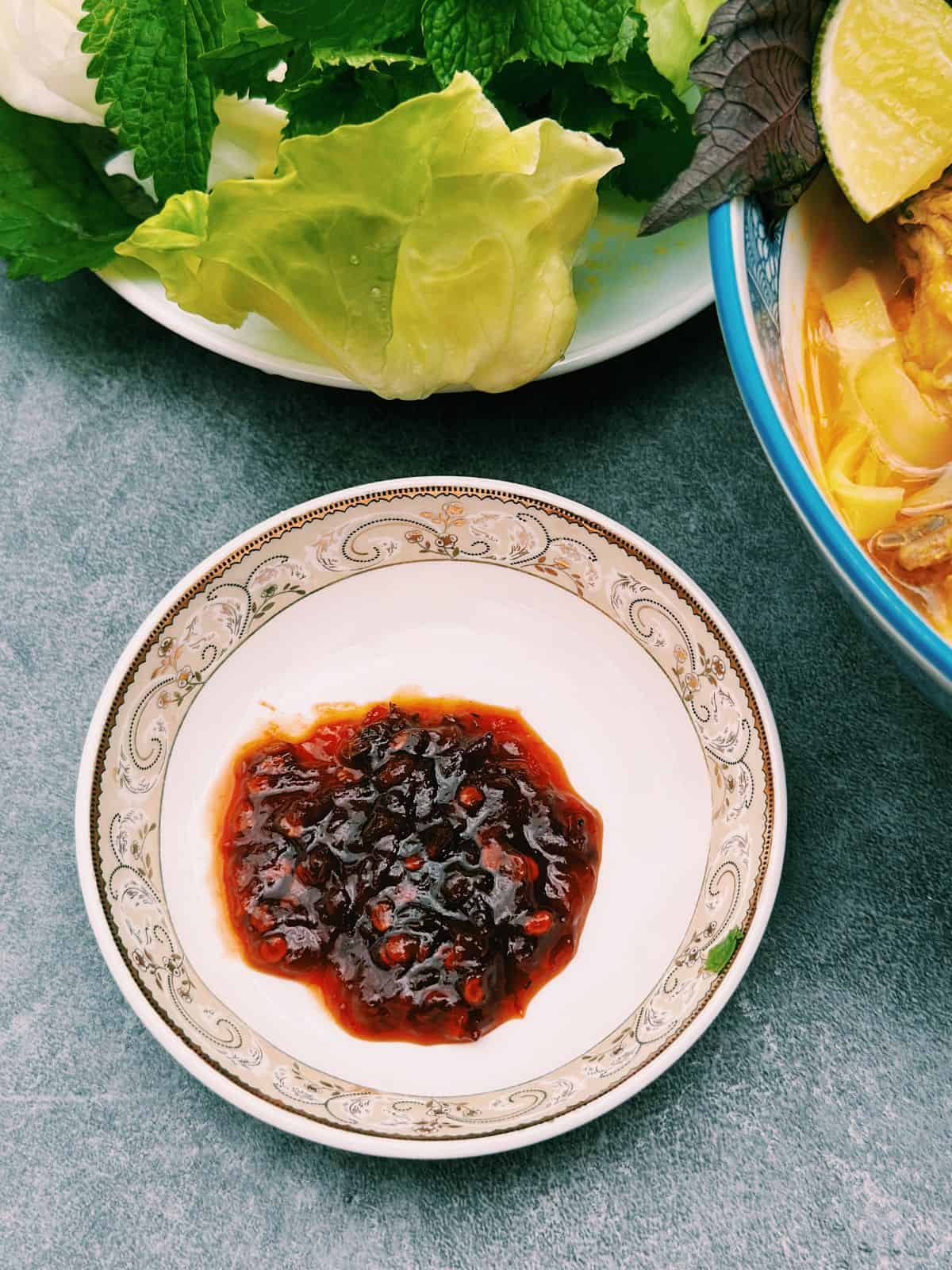

Instructions
Marinate
- Mince the garlic, pearl onions, shallots, and turmeric. I used a mortar and pestle to crush them this time. It’s the traditional way.

- Marinate the chicken with fish sauce, chicken powder, sugar, 1/3 the aromatics, annatto oil. Mix well and let it marinate for 30 minutes.
- Peel and devein the shrimps (if your shrimsp are small with thin, soft shells, no need to do). Marinate the shrimps with 1/3 the aromatics, fish sauce, sugar, and annatto oil. Mix well and allow it to marinate for 30 minutes.


Cook
- In a sauté pan, heat some peanut oil and sauté the remaining aromatics until fragrant. Then, add the chicken along with its marinade. If you like boiled quail eggs, add them at this stage. Adjust the seasoning with more fish sauce and stir-fry over medium-high heat until the chicken and quail eggs have absorbed the flavors.
- Add 4 cups (1 liter) of water and simmer over medium-low heat for approximately 30 minutes. Adjust the seasoning with more fish sauce and chicken powder. Mì Quảng is typically served with a moderate amount of broth, so the broth should be much saltier than your desired flavor.


- In a separate saucepan, heat some peanut oil and add the shrimps. Cook the shrimps over medium-low heat with the lid closed, occasionally stirring to ensure even cooking. When most of the liquid has evaporated and only a small amount of sauce remains, the shrimps are done.


Serve
- Cook the flat rice noodles following the instructions on the package, then rinse and drain them thoroughly.
- Place the noodles in a bowl and layer with vegetables and herbs. Add the chicken and shrimps, then pour the chicken broth over the noodles.
- Top the bowl with roasted peanuts and cracked sesame crackers, and perhaps give it a squeeze of lime. Mix everything together and enjoy.
- For those who enjoy spicy flavors, add some chili. Authentic Mì Quảng is typically served with Hoi An chili sauce and local green chilies, which can be quite spicy.

More authentic Vietnamese recipes
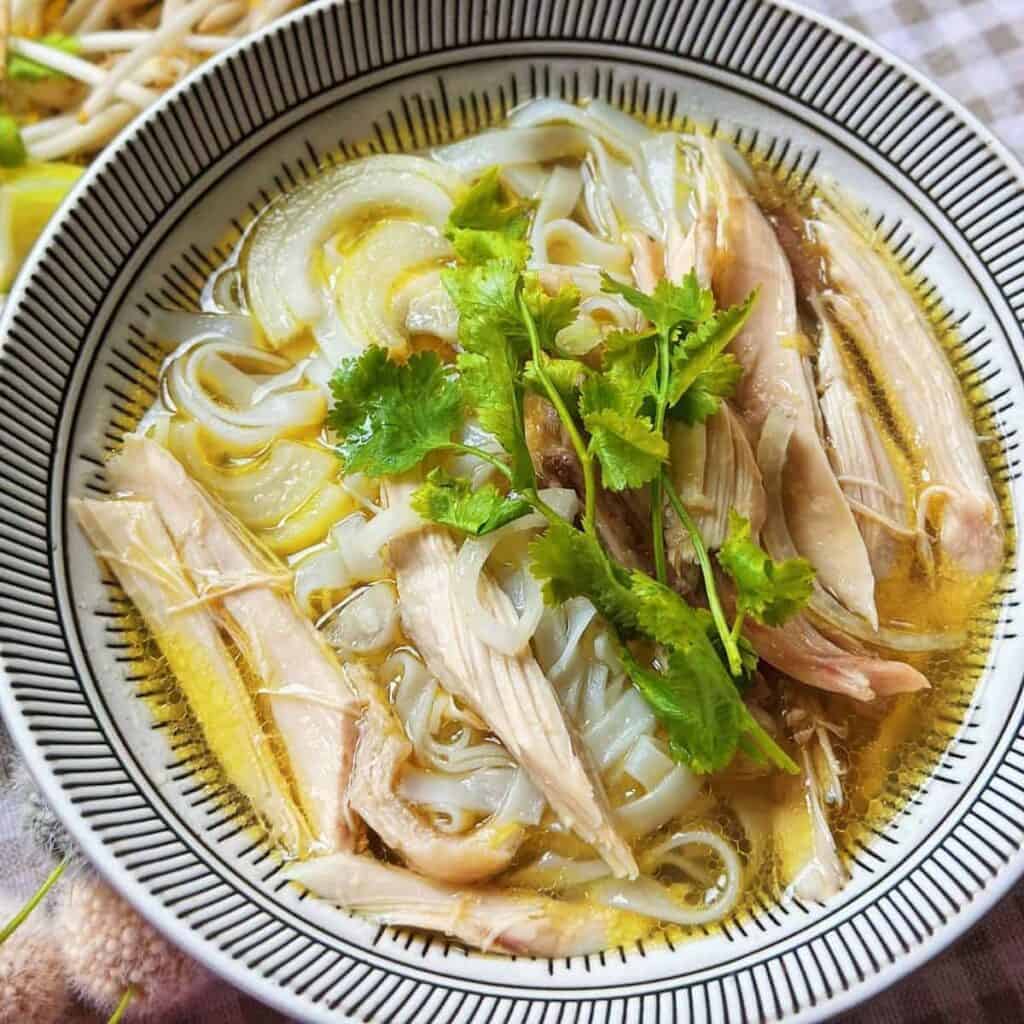

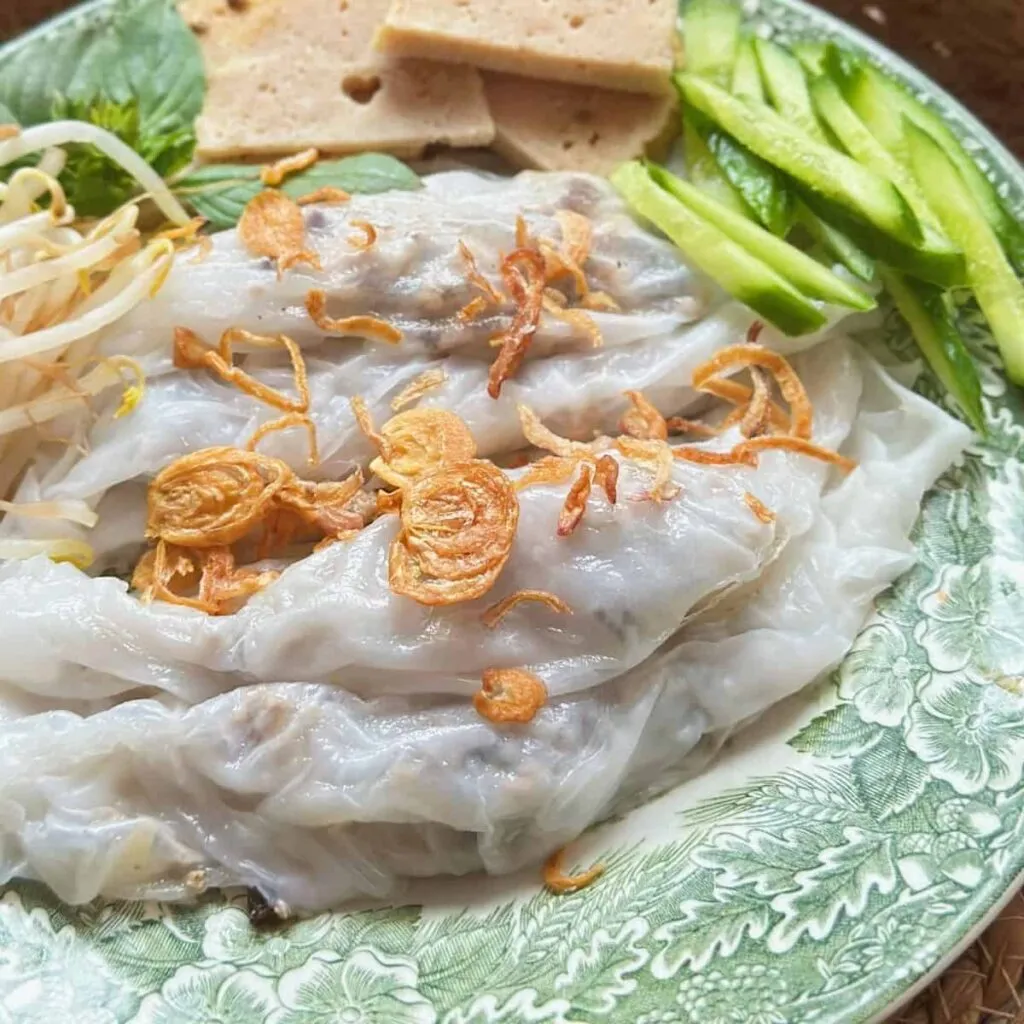
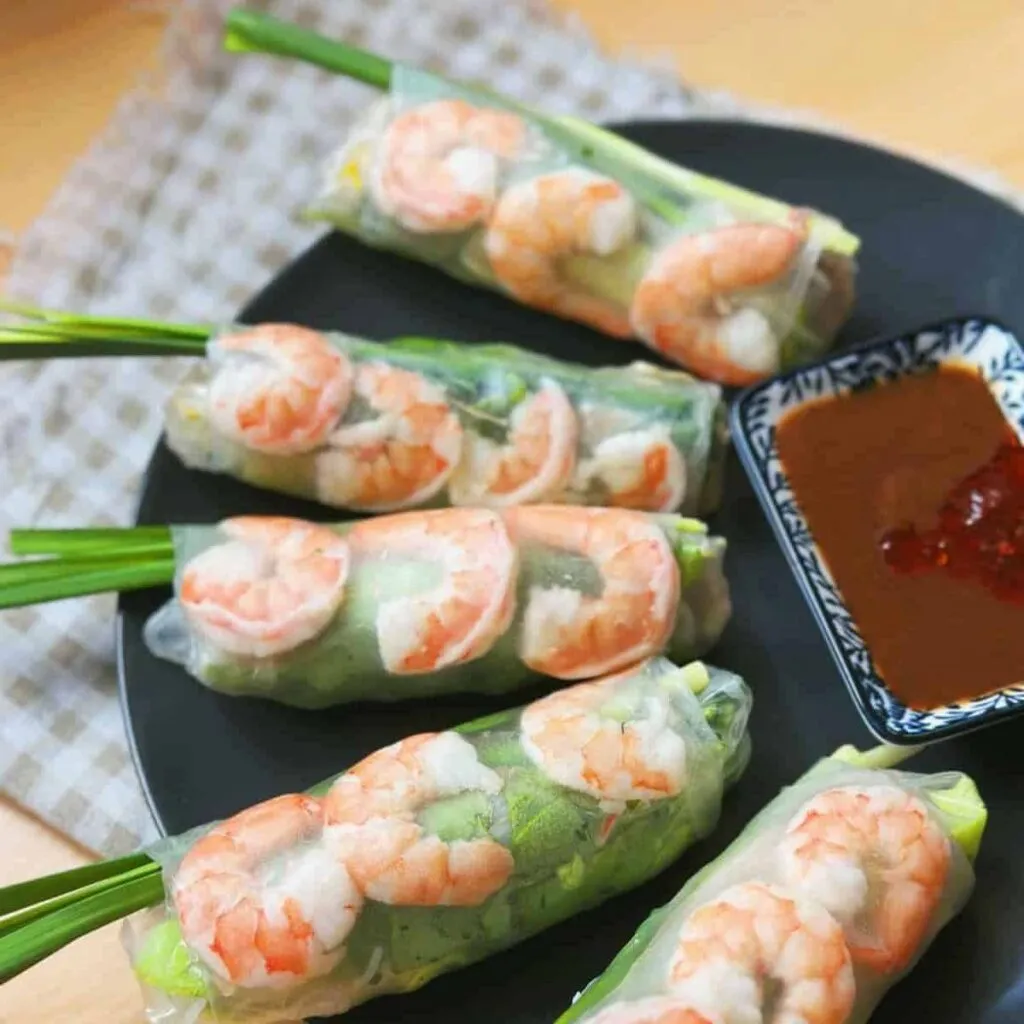

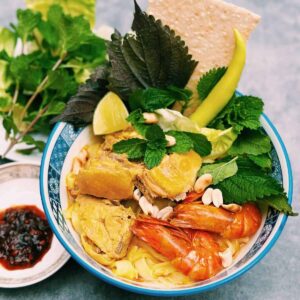
Authentic Mì Quảng – Vietnamese Turmeric Noodles
Ingredients
Chicken Marinade & Broth
- 1.5 pound chicken thighs (700g) (see note 1)
- 1 tbsp chicken powder
- 2 tbsp fish sauce
- 1 tbsp sugar
- 8 boiled quail eggs (optional)
- 2 tbsp annatto oil (or 2 tbsp cooking oil + 1 tsp paprika)
- 4 cup water (1 liter) (see note 2)
- 4 tbsp fish sauce (for the broth) (to your taste)
- 1 tbsp chicken powder (for the broth) (to your taste)
- ½ tbsp sugar (for the broth) (to your taste)
Shrimp Marinade
- 8 shrimps (with head and shells on) (see note 3)
- 1 tbsp fish sauce
- ½ tbsp sugar
- 1 tbsp annatto oil (or 1 tbsp cooking oil + 1/2 tsp paprika)
Aromatics
- 3 tbsp minced shallots
- 1.5 tbsp minced garlic
- 5 tbsp minced Vietnamese pearl onions (Củ Nén) (or regular pearl onions / onions) (see note 4)
- 2 thumb-sized pieces turmeric root (or 1 tsp turmeric powder)
Other ingredients
- Extra-virgin peanut oil (or cooking oil) (see note 5)
- 1 package Mì Quảng Noodles (see note 6)
- Vegetables (salads, baby mustard greens, bean sprouts, shredded banana blossoms)
- Herbs (mint, lemon basil, perilla, Thai basil…)
- Sesame crackers
- Roasted peanuts
- Lime
- Chili (optional)
Instructions
Marinating
- Finely chop the garlic, pearl onions, shallots, and turmeric together.
- Marinate the chicken with fish sauce, chicken powder, sugar, 1/3 the aromatics, and annatto oil. Mix well and let it marinate for 30 minutes.
- Peel and devein the shrimps (if your shrimps are small with thin, soft shells, this step may not be necessary). Combine the shrimps with 1/3 the aromatics, fish sauce, sugar, and annatto oil. Mix well and allow it to marinate for 30 minutes.
Cooking
- Heat some peanut oil in a sauté pan and stir-fry the remaining aromatics until fragrant. Then, add the chicken along with its marinade. If you like boiled quail eggs, you can add them at this point.
- Adjust the seasoning with more fish sauce and stir-fry over medium-high heat until the chicken and quail eggs have absorbed the flavors.
- Pour in water and let it simmer over medium-low heat for about 30 minutes. Adjust the seasoning by adding more fish sauce and chicken powder as needed. Mì Quảng is traditionally served with a moderate amount of broth, so the broth should be saltier than your preferred taste.
- In another saucepan, heat some peanut oil and add the shrimps. Cook the shrimps over medium-low heat with the lid closed, stirring occasionally to ensure even cooking. The shrimps are done when most of the liquid has evaporated, leaving only a small amount of sauce.
Assemble
- Prepare the flat rice noodles according to the instructions on the package, then rinse and drain them thoroughly.
- Arrange the noodles in a bowl and layer them with vegetables and herbs. Add the chicken and shrimps, then pour the chicken broth over the noodles.
- Top the bowl with roasted peanuts and cracked sesame crackers, and optionally, squeeze some lime juice over it. Mix everything together and enjoy.
- For those who like spicy flavors, add some chili. Authentic Mì Quảng is often served with Hoi An chili sauce and local green chilies, which can pack a punch of heat.
Notes
- Chicken thighs are more friendly to the Western palate, but in Vietnam, we typically use a broken-up whole chicken to cook Mì Quảng. You could also use drumsticks.
- You could use chicken broth instead of water to shorten the cooking time.
- In Vietnam, we use shrimps with heads and shells on, but you could remove them before cooking.
- Củ Nén are the local pearl onions used to make authentic Mì Quảng. They can be substituted with pearl onions or even regular white onions.
- Extra-virgin peanut oil is also an essential ingredient for cooking authentic Mì Quảng, but you can adapt with neutral cooking oil.

